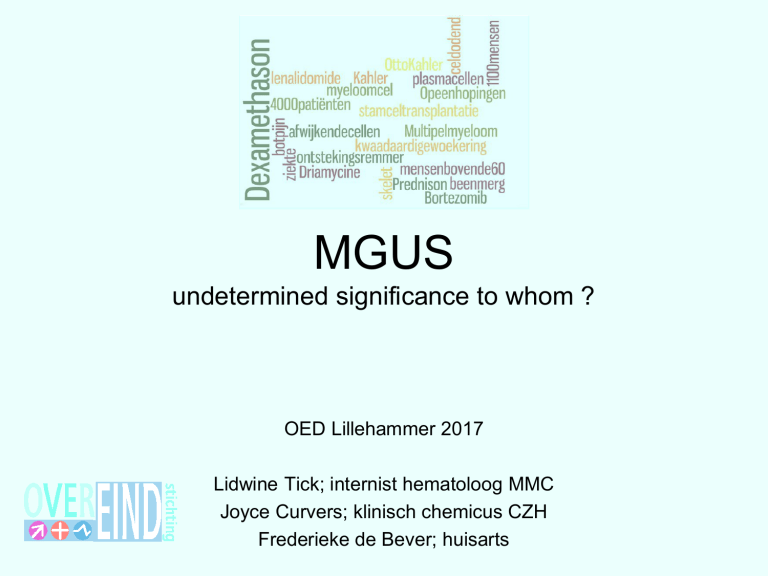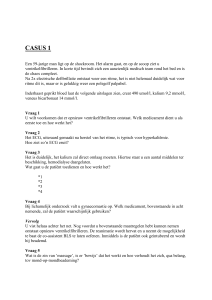
MGUS
undetermined significance to whom ?
OED Lillehammer 2017
Lidwine Tick; internist hematoloog MMC
Joyce Curvers; klinisch chemicus CZH
Frederieke de Bever; huisarts
Lillehammer – NL - MGUS
• Wat is de relatie?
Casus
•
•
•
•
Mw K
60 jaar
Heeft al langer last van haar rug
Ribben gestoten aan stoel, waarbij erg
veel pijn
• Chronisch moe
casus
U vraagt lab aan:
•
•
•
•
•
BSE
83
Hb
7.2
Kreatinine 90
eGFR (MDRD) >60
Alk Fosf
140
<20 mm/u
7.5-10 mmol/L
50-100 µmol/L
>60 ml/min
33-98 U/L
Casus
Verwijzing naar 2e lijn vanwege
aanhoudende pijnklachten en afwijkend
lab…
Dreigende humerus
en wervelfractuur
Casus
=======================================================================
BLOED ALGEMEEN
bezinking erytrocyten (BSE)
H 79
<20
mm na 1 u
hemoglobine
L 6.1
7.5-10.0
mmol/L
MCV
83
80-100
fL
trombocyten
180
150-400
/nL
leukocyten
5.1
4.0-10.0
/nL
ASAT
ALAT
alkalische fosfatase
gamma GT
ureum
kreatinine
kreatinine klaring (MDRD)
calcium
fosfaat
eiwit totaal
albumine
CRP
parathormoon
25-OH vitamine D
H 54
H 75
H 141
H 213
H 11
95
L 56(2)
HH 2.99
1.18
H 100
44
H 8.0
L 1.6
58
<31
<34
33.0-98.0
<38
U/L
U/L
IU/L
U/L
2.5-6.4
50-100
>60
mmol/L
µmol/L
mL/min
2.10-2.55
0.80-1.50
63-83
35-50
<6.0
mmol/L
mmol/L
g/L
g/L
mg/L
1.6-6.9
>50
pmol/L
nmol/L
Uitslagen lab
IMMUUNSYSTEEM (HUMORAAL)
IgG
H 36.6
7.0-16.0
IgA
L 0.6
0.7-4.0
IgM
LL 0.21
0.50-3.00
monoclonaal Ig (kwal)
* positief negatief
type monoclonaal Ig
IgG kappa
monoclonaal Ig (kwant)
21.6
negatief
Beenmerg-aspiraat:
65% plasmacellen
Beleid:
Chemokuur en autologe stamceltransplantatie
g/L
g/L
g/L
g/L
Multiple Myeloom
plasmocytoom, ziekte van Kahler
•
•
•
•
•
per jaar 700 nieuwe MM patiënten
Gemiddelde leeftijd rond 70
Iets meer mannen dan vrouwen
overleving 6-7 jaar
MM begint bijna altijd met botklachten, vooral
wervelkolom, ribben en bekken.
• Later klachten agv verdringen cellen beenmerg*,
nierinsufficientie agv verhoogd calcium en Mproteine.
Klachten bij multiple myeloom
•
•
•
•
•
•
•
•
Botlaesies, osteopenie, (spontane) breuken (75%)
Botpijn (70%), dwarsleasies
Anemie (70%)
Nierinsufficiëntie (50%)
Hypercalciëmie (30%) polyurie, anorexie,
misselijkheid, constipatie, verwardheid, coma
Hyperviscositeitssyndroom (2%)
Recidiverende infecties
Bloedingsneiging (slijmvliesbloedingen neus,
maag-darm-kanaal, urinewegen)
Geschiedenis
At age 39, developed fatigue and bone pain from several
fractures. She died 4 years later; autopsy showed that her
marrow was replaced by a red, gelatinous substance
(A) Henry Bence Jones (B) Otto Kahler (C) Jan Waldenström
Hematopoiesis
CD20 Expressie tijdens B-cel
ontwikkeling
Beenmerg
Pluripotente
stamcel
Lymphatische
stamcel
Bloed, lymfklieren
Pre-B cel
B cel
Geactiv. B Plasmacel
cel
CD20
CD38
Clinical spectrum of clonal expansions of
transformed plasma cells in patients
• Stable intramedullary
expansion
• Asymptomatic.
MGUS
(premalignant)
Normal
cell
Transformed
Cell
• Progressive intramedullary
expansion.
• Anemia, bone pain, infections
• Lytic bone disease.
• Incurable, limited survival.
Multiple myeloma
(malignant)
•13000 deaths/yr in USA.
Manifestations of Clonal Plasma Cell Proliferation
Osteoclast
Osteoblast
LYTIC BONE DZ
HYPERCALCEMIA
Erythropoiesis
ANEMIA
Ig deposition
Cast nephropathy
RENAL FAILURE
Immune-paresis
Hypogamm
INFECTION
Orgaan of beenmergdisfunctie
CRAB criteria
– Serum calcium >2.75 mmol/l
– Nierinsufficiëntie; serum kreatinine >177 μmol/l
– Hb daling ≥ 1.5 mmol/l of Hb < 6.3 mmol/l
– Botlaesies: lytische laesies of osteoporose met
compressiefracturen
– Overige symptomatologie: hyperviscositeit,
amyloïdose, recidiverende bacteriële infecties
(> 2 episodes in 12 maanden)
Orgaan of beenmergdisfunctie
CRAB criteria
– Serum calcium >2.75 mmol/l
– Nierinsufficiëntie; serum kreatinine >177 μmol/l
– Hb daling ≥ 1.5 mmol/l of Hb < 6.3 mmol/l
– Botlaesies: lytische laesies of osteoporose met
compressiefracturen
– Overige symptomatologie: hyperviscositeit,
amyloïdose, recidiverende bacteriële infecties
(> 2 episodes in 12 maanden)
Biological events related to progression to multiple myeloma.
Neha Korde et al. Blood 2011;117:5573-5581
©2011 by American Society of Hematology
Treatment course
Asymptomatic
Symptomatic
MGUS
Stable MM
Acute
Pancytopenia
Plasma cell leukemia
M protein
Treatments
Years
Months
Days
Sluipmoordenaar
• Patienten presenteren zich vaak in ver
gevorderd stadium.
Herman Kattemölle, Ziekte van Kahler
“Achteraffen”:
Fragment:
Moet ik boos zijn?
Moet ik verwijten?
Een klacht indienen?
Of zal het slijten
Dat knagende gevoel van “hadden ze nou maar”
Of is het niet ontdekken toch verdedigbaar?
Tenslotte is die Kahler een sluipmoordenaar
Maar ik weet het niet, ik weet het niet
Het voelt nog steeds wat raar.
Casus
• Patiënt; dhr. B.; 70 jaar
• Jaar bestaande klachten van ernstige
vermoeidheid
• Analyse door huisarts levert geen
verklaring; doorgestuurd naar internist
• Internist doet uitgebreid onderzoek,
waaronder een eiwitspectrum.
(vroeg)diagnostiek
Laboratoriumonderzoek
Eindorgaanschade inschatten (2e lijn):
• Hb, calcium, kreatinine, albumine,
• IgG, IgA, IgM
• Eiwitspectrum en vrije lichte ketens
• totaal eiwit in urine, evt Bence-Jones eiwit
Wat is een M-proteine eigenlijk ?
•
•
•
•
een monoklonaal immuunglobuline
geproduceerd door 1 B-cel kloon
afhankelijk van zware keten MM of MW
lichte ketens
Detectie monoklonale Immuunglobuline
29
Detectiemethode: electroforese
• anti-sera tegen zware ketens GAM en
lichte ketens kappa en lambda
30
Lichte ketens
• Meer lichte ketens dan intact Ig
Nature Reviews Nephrology 5, 621-628 (November 2009)
Vrije lichte ketens
Welke typen Ig bij myeloom ?
75-80% monoclonaal Ig
10-20% enkel lichte ketens (snelle renale klaring, geen serum paraproteïnen
urine electroforese)
Non-secretoire myelomen zeldzaam (< 1%)
Lichte ketens (5-10%)
Biklonaal (~5%)
IgD & IgE (<1%)
IgG (50-60%)
IgM (15-20%)
IgA (10-15%)
34
Uitslagen casus
o.a.
• Hb 9,7 mmol/l, BSE 26 mm/u, MDRD
(CKD-EPI) 85 ml/min, calcium 2.28
mmol/L
• Monoclonaal immuunglobuline positief,
type monoclonaal IgG kappa (3,6 g/L)
• Skeletstatus; geen aanwijzingen
botlaesies (Kahlerhaarden)
Diagnose MGUS
Diagnose; MGUS
Wat betekent MGUS ?
• Multiple Granulocytosis of Unknown Subclass
• Multifocal Granulomatosis of Unclassified Source
• Monoclonal Gammopathie of Undetermined Significance
Diagnose; MGUS
Wat betekent MGUS ?
• Multiple Granulocytosis of Unknown Subclass
• Multifocal Granulomatosis of Unclassified Source
• Monoclonal Gammopathie of Undetermined Significance
Klachten bij MGUS
• Geen klinische verschijnselen; dus per toeval
ontdekt
• Geen botlaesies, geen anemie
• Uitzondering; neuropathie (IgM MGUS)
MGUS
• Prevalentie (toetsvraag); 1% van totale populatie,
3% van mensen boven de 70 jr.
• 1% per jaar; progressie naar Multiple Myeloom
(ziekte v. Kahler), zelden ziekte van Waldenström
(toestvraag: geen leukemie)
• Bij 2-5% verdwijnt M-proteïne in de loop van de
tijd
Kyle NEJM 2006
Wat is MGUS
• Voorstadium van Multiple myeloom (Kahler)
MGUS Prognostische Score
Risico Factoren
• M-proteine >15g/L
• Non-IgG MGUS
• Abnormale vrije lichte
keten ratio
Progressie risico in 20 jrs
0
5%
1
21%
2
37%
3
58%
Probability of Progression SMM versus MGUS
M-proteine>30
BM PC 10-60%
Geen CRAB
Kyle R et al. N Engl J Med 2007;356:2582-2590
Low risk MGUS
(5% risk of progression at 20 years)
• Low risk MGUS (40% of MGUS)
1. IgG subtype
2. M-protein<15g/L
3. normal SFLC ratio
in the absence of concerning symptoms
such as anemia or poor renal function
• no further initial evaluation is required
Summary
• Low Risk MGUS (40% of MGUS)
–
–
-
risk of progression 5% at 20 years
do not need BMB
Follow up at 6m, if stable 1-2 yrs
alternatively if concerning symptoms
• Intermediate and High risk MGUS
– risk of progression 20-60% at 20 years
– consider BMB, bone imaging, MM labs
– Ongoing follow-up 6m then annually
• Smoldering MM
– need careful ongoing follow-up q6m
– but at 5 years 50% will not progress
• IgM MGUS needs special attention
Discussie
Kunnen de controles bij MGUS bij de huisarts
plaats vinden?
• Zo ja, wanneer verwijst specialist terug naar HA
• Zo ja, wanneer verwijst HA weer naar specialist
Controle door huisarts
-labcontroles (pakket MGUS);
eiwitspectrum,
Hb, Ca, nierfunctie
Let’s do it the MGUS -way
Toetsvragen
2.De prevalentie van MGUS is groter dan 0.2 %
(goed;1-3%)
3.MGUS kan ontaarden in een leukemie (fout)
4.De diagnose MGUS wordt primair gesteld op
basis van het eiwitspectrum (goed, wel uitsluiten
MM)
5. De follow-up van MGUS kan door de huisarts
gebeuren










